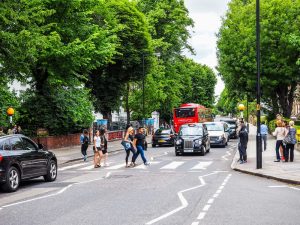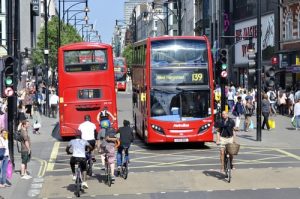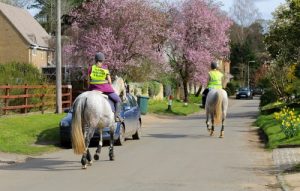- UP TO £400 OFF*
- OFFER VALID UNTIL 31st July 2024
Driving around in an HGV gives you even more responsibility than that of a car driver. Your vehicle is capable of causing a lot more damage to people and property than a car, if you were to slip up on spotting and avoiding the common hazards of the road. There are 13 common types of road hazard you should be prepared to spot in the blink of an eye, and it’s not as hard as it seems once you know what they are and start to put your driving instinct into practise. It’s these types of hazards you’ll be expected to identify during your hazard perception theory test, and to demonstrate during your practical test, so the earlier you become aware of them and try to memorise them the better your chances of passing and becoming a great driver.
Hazards are anything that mean you need to change speed or direction, or stop completely. With that in mind, you can easily tell the difference between a potential or a developing hazard. A potential hazard is one in which you need to be aware of what might happen, but it hasn’t started to happen yet, so it’s unclear whether you’ll need to change speed or direction or to stop. A developing hazard is something which is underway already and will require you to do one of these things. Your theory test will ask you distinguish between the two. Here are the most common types of potential or developing hazards you’re likely to encounter in your hazard perception test.
This is a very common hazard in your hazard perception test because it involves something which is frequently found on all the country’s roads – crossings. Anyone approaching a crossing, including individual pedestrians or school crossing officers, is a hazard you need to be aware of. The same applies if a traffic control signals to stop to allow pedestrians to cross.
To avoid this hazard, you need to be constantly on the lookout for people who might be about to use a crossing as you approach, and slow down in anticipation if you see any. You’ll also need to stop and wait if they step onto the crossing, and do this a little earlier if the road conditions are bad, for example, because of water or ice.

What you should never do is wave to pedestrians to indicate that they should cross. Once you’ve stopped, it’s up to them to check there’s no traffic coming from the other direction and not up to you to tell them when to cross, just in case it’s not yet safe.
Schools are where particular care must be taken, due to the high number of children who may be walking, cycling, running across the road or playing. As soon as you enter these areas you will need to be alert and ready to take action. This means you’ll need to drive slowly past them, and if you reach a crossing where pedestrians are on the crossing or a crossing officer is displaying a ‘stop’ sign you must stop.
Separate from the hazard posed by schools, children present a hazard of their own whenever they are close to the road. Children’s concentration on their own safety can be lacking, so it’s up to you as a driver to make up for that with your own alertness and quick thinking. Never assume a child is aware of any vehicles around them, and that they could step or cycle into your path at any time. If they’re playing a game, and they’re playing with friends, this could mean multiple children could run into the road, rather than just one.
And it’s not only small children who can be a hazard to drivers and themselves on the roads. Teenagers and young adults can also walk or run into the road without warning, and can be less perceptive to danger than older adults.
As well as younger pedestrians, you will also need to be aware of elderly people using the crossings. Older people may not have an accurate perception of your speed and distance, and may be slower to use a crossing than other people, so you must be patient. If you see older people using crossings, or stepping into the road, you need to slow down immediately and safely.
People with vision problems, blind or partially sighted people, and other disabled people may not be able to see or hear you, and may not be able to cross the road quickly. Look out for guide dogs, white canes, wheelchairs etc, and adjust your speed appropriately. As with elderly people, don’t encourage them to move across the road any faster than they are able to, simply be patient and wait for them to get safely across.
Of course, even able-bodied adults can misjudge the dangers of the road, and fail to spot your vehicle or any danger posed by traffic. This is especially the case if they are under the influence of alcohol or drugs, or are distracted with a task on or near the roadside such as loading, unloading or working on a vehicle. That’s why all pedestrians should be considered a potential hazard if they are anywhere near the road.
All drivers should be constantly on their guard when it comes to looking out for cyclists. Cyclists can approach you at varying speeds, appearing suddenly and posing a potential or developing hazard to drivers. This is another very important question in your hazard perception test.
Cyclists may need to overtake your vehicle, or vice versa, and need the space to do so safely. Not all roads are ideal for this purpose, so you will need to be aware of any narrow roads and how this might affect a cyclist riding alongside you, giving way where necessary, particularly in instances where a cyclist needs to pick up speed after a stop or turn. Because they’re on bikes rather than in cars, cyclists who are involved in a collision with a vehicle are much more likely to be hurt or killed than the driver of that vehicle. Motorcyclists tend not to experience the exact same problems on the road as cyclists do, but in their own way can be equally vulnerable.

Because of the high speeds they can reach, they can suffer serious injuries if knocked off their bikes. This is compounded by the fact that they are also smaller than other vehicles, and drivers need to be vigilant to make sure they spot motorcycles in good time and bear in mind their vulnerability in comparison with other vehicles.
As with cyclists, horse riders travel much more slowly than other traffic. That can mean they’re overtaken frequently by vehicles, and may not be given enough room on the road. In addition, driving too closely to horses, revving engines or overtaking at speed can startle horses, which also poses a risk to riders if the horse throws them or runs away.

When approaching horse riders on the road, drive slowly and approach carefully, giving them plenty of room. This is most widely asked question in your hazard perception test.
In terms of hazards – things which may make you change speed or direction, or stop completely – other vehicles pulling up or moving off are another very common one you will encounter. You should always assume that drivers of other vehicles haven’t seen you as they pull in or move off, and be ready to stop or change direction or speed as they do so. Indicators should be used by other vehicles when they perform these actions, but you can’t rely on this always being the case as other drivers may be distracted or forget to signal.
The same applies if vehicles are trying to park, and are moving into position while paying attention to their parking space than to other vehicles that might be approaching. You should give drivers plenty of room while they’re trying to park, always assuming they haven’t seen you in the process. Buses, trams and coaches which are large and may need to stop frequently for passengers should be given plenty of space, and you should assume they may need to pull in at bus stops or tram stops without much warning.
All vehicles such as buses, coaches and trams should be given priority as they move off, so bear this in mind as you share the road with them.

When vehicles meet on the road it creates a common potential hazard which can cause serious accidents if you’re not prepared to recognise the dangers in advance. On narrow roads where cars may be double parked, there may only be space for one vehicle at a time to drive along it or there may be space for two if they drive at a controlled speed and take extra care.
In this instance, it depends on which side the obstruction appears as to who should give way. If it’s on your side, you’ll need to give way to traffic coming from the other direction. Exceptions to this rule are if the other driver signals for you to go first, or if there are signs telling you specifically that traffic on the other side should give way.
Sometimes, even if you technically do have priority, you’ll need to make a call on whether going first will cause further issues on the road such as traffic jams or difficulties for larger vehicles coming up hills. In this situation you can choose to give way to the other vehicle. You may also find that narrow roads are deployed to slow traffic in some areas where cars may otherwise be speeding. In these cases you’ll find signs warning you of the potential hazard.
Vehicles emerging into the road you’re driving on present a potential hazard, whether that vehicle is driven by you or another driver. This is particularly the case when there are long or slow vehicles emerging. A good driver with a lot of experience will be able to both emerge as safely as possible, and also understand the problems other drivers might have when emerging. Putting yourself in the position of the other driver will help you to stay safer on the road.
Vehicles that are turning left or right will most likely reduce their space and change their position on the road, all of which form a potential hazard to other drivers. Drivers who are turning left or right should always give other drivers fair warning, and provided they do there’s no reason this should cause a potential hazard to progress into anything more.
If a vehicle is reversing onto a major road or out into the path of other cars in any other space, this is a potential hazard. That’s because doing so can mean you need to change speed or direction, or stop completely. If you see a car doing this, you should bear in mind that their vision may not be as clear as it would be if they were driving forwards, and always assume they haven’t seen you or can’t tell how close you are. U-turns can also create potential hazards. Most drivers aren’t aware of the true turning circle of their vehicle so they may need to turn a u-turn into a three point turn unexpectedly.
Large vehicles can be the source of potential hazards because they present a visual obstruction to other drivers, as well as a physical obstruction that can block roads in some situations. Larger vehicles can be slower than others, and need more room to swing out around corners. Both of these things can obstruct other drivers, forcing them to change speed or direction, or stop completely. You may also find larger vehicles can block narrow roads, and if they are making deliveries they may also stop by the side of the road and cause a further potential hazard.
You should always be aware of amber flashing lights on utility vehicles which warn of a potential hazard. These vehicles could be very slow moving and working as they go. Then there are the flashing lights of often extremely fast moving emergency vehicles, which present a different but equal kind of potential hazard.
Just fill in your details below and we’ll send you a free theory test practice with.
Just let us know your score...
We reserve the right to contact you in the
future via this email
By Signing up, you agree to our Terms & Privacy Policy
By Signing up, you agree to our Terms & Privacy Policy
By Signing up, you agree to our Terms & Privacy Policy
By Signing up, you agree to our Terms & Privacy Policy
By Signing up, you agree to our Terms & Privacy Policy